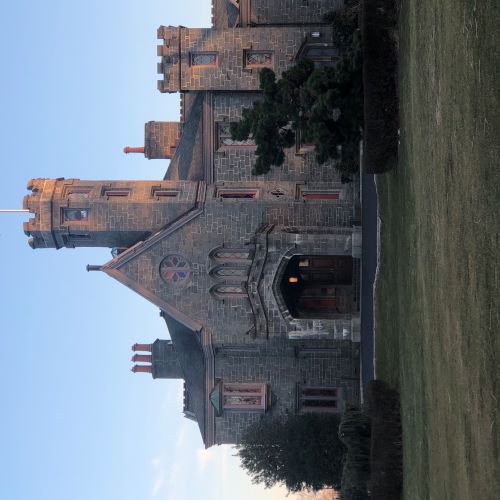Whitby Castle, designed by Alexander Jackson Davis, was built in the 1850s.
A Little Local History
Boston Post Road Historic District
By Paul Hicks
At a time when people are clamoring to cancel culture and topple monuments around the country, our National Historic Landmarks deserve our care and protection more than ever.
The United States National Historic Landmark (NHL) program operates under the auspices of the National Park Service, and recognizes buildings, structures, objects, and sites individually as well as part of historic districts that have been designated as historically or architecturally significant.
There are only fifteen National Historic Districts in Westchester County, among them the Boston Post Road Historic District in Rye. Added to the National Register of Historic Places in 1993, it encompasses five contiguous properties.
Following are highlights of their histories excerpted from a time-line composed by Suzanne Clary, head of the Jay Heritage Center board:
1661: Rye founder John Budd purchases an area called “Apawamis” from the Native American Siwanoy tribe.
1745: John Jay’s father purchases 250 acres and buildings from John Budd’s great-grandson. Additional purchases increase the Jay holdings to 400+acres that once included today’s Jay Estate, the Jay Cemetery, Pine Island, Hen Island, and the Marshlands.
1805: Jay Family Cemetery established by John Jay, who is buried there in 1829.
1831-1838: Edward Lamb Parsons purchases Lounsbury (aka Lounsberry) family property and builds Greek Revival mansion.
1836-1838: Greek Revival mansion built on Jay property by Peter Augustus Jay, son of John Jay.
1852-1854: Gothic Revival mansion, and built by the owner, William P. Chapman, on property just north of the Parsons estate. The mansion was called “Whitby Castle”.
1904: Jay Estate passes out of Jay family to a succession of private owners.
1920: Whitby Castle becomes Rye Country Club. Golf course built in 1925.
1965: Rye Country Club purchased by City of Rye.
1966-67: Mrs. Walter Devereux donates 120 acres of Jay Estate to Westchester County as parkland and 23 acres-plus Jay Mansion to Methodist Church.
1972: “Devereux Reservation” rededicated as “Marshlands Park”.
1978: Fanny Wickes Parsons, owner of Lounsbury, donates 17 acres to Westchester County Parks; Friends of Marshlands established as stewards of 137-acre preserve.
1979: Methodist Church sells former Jay residence and 23 acres to developer.
1980: Additional 13.5 acres of Lounsbury property donated to the City of Rye by the Parsons family.
1982: Boston Post Road Historic District (all five properties) added to the National Register of Historic Places.
1990: Jay Coalition chartered by New York State to protect and interpret John Jay’s legacy in Rye and safeguard 23-acre Jay property.
1992: Jay Property acquired by Westchester County Parks (21.5 acres), and Jay Heritage Center (1.5 acres).
1993: Designation of Boston Post Road Historic District as National Historic Landmark by US Dept. of the Interior — archaeological, architectural significance and association with John Jay cited.
1995: Lounsbury sold by the City of Rye to David Parsons, a descendant of Edward Lamb Parsons.
1997: New York State Parks Acquires 90 percent interest in 21.5- acre section of Jay Property; Westchester County retains 10 percent.
2004: Jay Heritage Center added to African American Heritage Trail.
2009: The 23-acre Jay Estate is included in the Hudson River Valley National Heritage Area.
2013: Stewardship of the Jay Estate entrusted to Jay Heritage Center.
For more information about the Boston Post Road Historic District, visit the Jay Heritage Center website and use this link, jayheritagecenter.org/about/boston-post-road-historic district. The Center continues to run programs, albeit virtually, during the pandemic.















